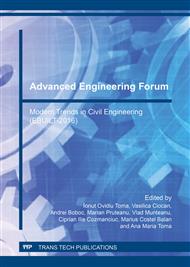p.366
p.372
p.380
p.389
p.397
p.407
p.413
p.418
p.426
A Proposal for Controlling Work Progress on Excavation Projects Using Digital Photographs
Abstract:
Current practice in excavation projects is characterized by a deficient control of work progress that includes estimates of daily work progress by indirect means such as manual records of truck movements, estimates of soil swelling and occasional topographic measurements (usually at start and end of projects). In this article we propose a procedure to calculate earth work volume and progress by using geotagged digital photographs taken at the construction site. This methodology helps construction managers to improve excavation progress control and it systematizes excavation records. The procedure is grounded on literature review, the experience gained from controlled experiments and its application on a case study. With a relatively low effort (approx. 3 hrs.) the proposal enabled us to measure excavation work progress from around 50 geotagged digital photos with a precision of about 8-10% as compared to the traditional excavation volume estimate obtained from truck movement records. Best results were realized for large earth movements recorded on a weekly basis. Precision decreased for small earth movements (e.g., daily work progress control). The proposal includes recommendations for capturing the digital photos; formation of a point cloud model using photogrammetric software; formation of a mesh model and calculation of the excavation volume. Considerations for obstructing construction equipment and complex geometries are included.
Info:
Periodical:
Pages:
397-404
Citation:
Online since:
March 2017
Authors:
Price:
Сopyright:
© 2017 Trans Tech Publications Ltd. All Rights Reserved
Share:
Citation:


